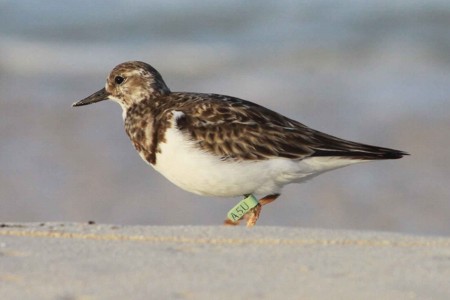Fall Migration - Shorebirds in the Caribbean

Fall shorebird migration is on!
The Caribbean’s location between North American breeding sites and South American wintering grounds makes it a great place to experience shorebird migration. With birds from all parts of North America traveling through the Caribbean, dozens of species can be expected, with each day bringing new flocks of birds and the possibility of exciting vagrants.
Shorebirds are great fun to observe, but some species are quite challenging to identify, especially the so-called “peeps”—the smallest sandpipers (Semipalmated [Calidris pusilla], Least [C. minutilla], which are the most common in the Caribbean followed by Western [C. mauri] and White-rumped Sandpipers [C. fuscicollis]). Other groups of shorebirds which can be difficult to identify to species, especially when both species aren’t present, include the yellowlegs (Greater [Tringa melanoleuca] and Lesser [T. flavipes]) and the dowitcher-esque birds (Short-billed [Limnodromus griseus], Long-billed [L. scolopaceus] and Stilt Sandpiper [Calidris himantopus]). When identifying shorebirds, be sure to note the overall size and shape of the bird (compare it something you know, especially other nearby shorebirds) and pay special attention to the size, shape, color and length of the bill and legs. Keep in mind that age or season-related (breeding/non-breeding) changes to field marks in the same species may be greater than differences between species. Also, vocalizations are an underutilized method for identifying these species and are often more diagnostic than field marks.
Because shorebird identification often relies on very subtle field marks, single individuals may not be identifiable without nearby birds to compare field marks with. Shorebirds are easiest to identify when they form flocks of multiple species, allowing differences in field marks to be compared directly. Knowing which species are common and which are rare in your area is also very important. Understanding migration routes, timing and winter ranges are important in knowing when a species is expected or extremely unusual. Please write field notes or photograph rarities — such as Long-billed Dowitcher, Baird’s Sandpiper (Calidris bairdii) and other rare Caribbean species — when you find them. And most importantly, don’t force an identification. If you are not sure about that Western Sandpiper, Greater Yellowlegs or Short-billed Dowitcher, eBird Caribbean has options for entering such things as peep sp., Greater/Lesser Yellowlegs and Short-billed/Long-billed Dowitcher.
To aid you in your efforts, check out these resources on shorebird ID:
•Caribbean Birding Trail Shorebird Gallery
•Caribbean Birds – SCSCB – there are many shorebird photos here, along with helpful captions and comments on identification, plumages and molt.
•Caribbean Bird ID – Monitoring
This fall keep track of shorebirds and other migrants you see by making a special effort to visit sites especially good for shorebirds (e.g., mudflats, tidal flats) and submitting frequent checklists to eBird Caribbean. Submitting complete checklists of the species (and numbers of individuals) you see, even when few migrants are present, will allow you and other eBirders to track migration as it happens and help shorebird conservation. Conservation scientists are working to conserve shorebird populations by identifying migration patterns, travel routes, and stopover sites used by migrating shorebirds. Protecting stopover sites, important places along migration routes where birds stop to rest and feed in between flights, in places like the Caribbean is especially important for conservation. The checklists you submit to eBird Caribbean will be made available for conservation scientists to use to study Caribbean-wide migration patterns and may help identify previously unknown stopover sites in the region.Finally, if you can visit a site more than once, visit as often as you can and use eBird Caribbean to participate in the Caribbean Waterbird Census (CWC), an important waterbird monitoring and conservation initiative. Recommended protocols for shorebird/waterbird counts and information about how to enter CWC checklists into eBird are here.
Counting birds is not the only way you can help contribute to shorebird citizen science in the Caribbean. Several species of sandpipers and plovers are being banded on the breeding grounds or at migration stopover sites. Individual birds are given unique combinations of bands or flags with individual codes written on them. Resightings of these birds by scientists and birders, especially during migration, are allowing scientists to learn much more about these birds and their migration patterns.

Migrating Sanderling (Calidris alba) with light green flag (3TL) on upper left leg. Photograph by Doug Weidemann.

Wintering Ruddy Turnstone from Sandy Ground, Anguilla during February 2012. Note the code (A5U) printed on the light green flag. Photograph by Richard Brown.
If you spot a marked shorebird and would like to report it, record (photograph if possible) the color combinations and any letter/number codes. Then, after submitting your sightings to eBird Caribbean, go to bandedbirds.org (shorebirds only) or the USGS band reporting website to enter information on the marked individual. More information on how to document marked birds can be found on these websites as well.
Remember to take the time to enjoy the excitement of shorebird migration this fall and don’t forget to enter your counts in eBird Caribbean! Good luck!
Doug Weidemann, Lisa Sorenson and Jeff Gerbracht
Special thanks to Ted Eubanks and Richard Brown for generously sharing their shorebird photographs and Ted Eubanks for his helpful ID tips!
